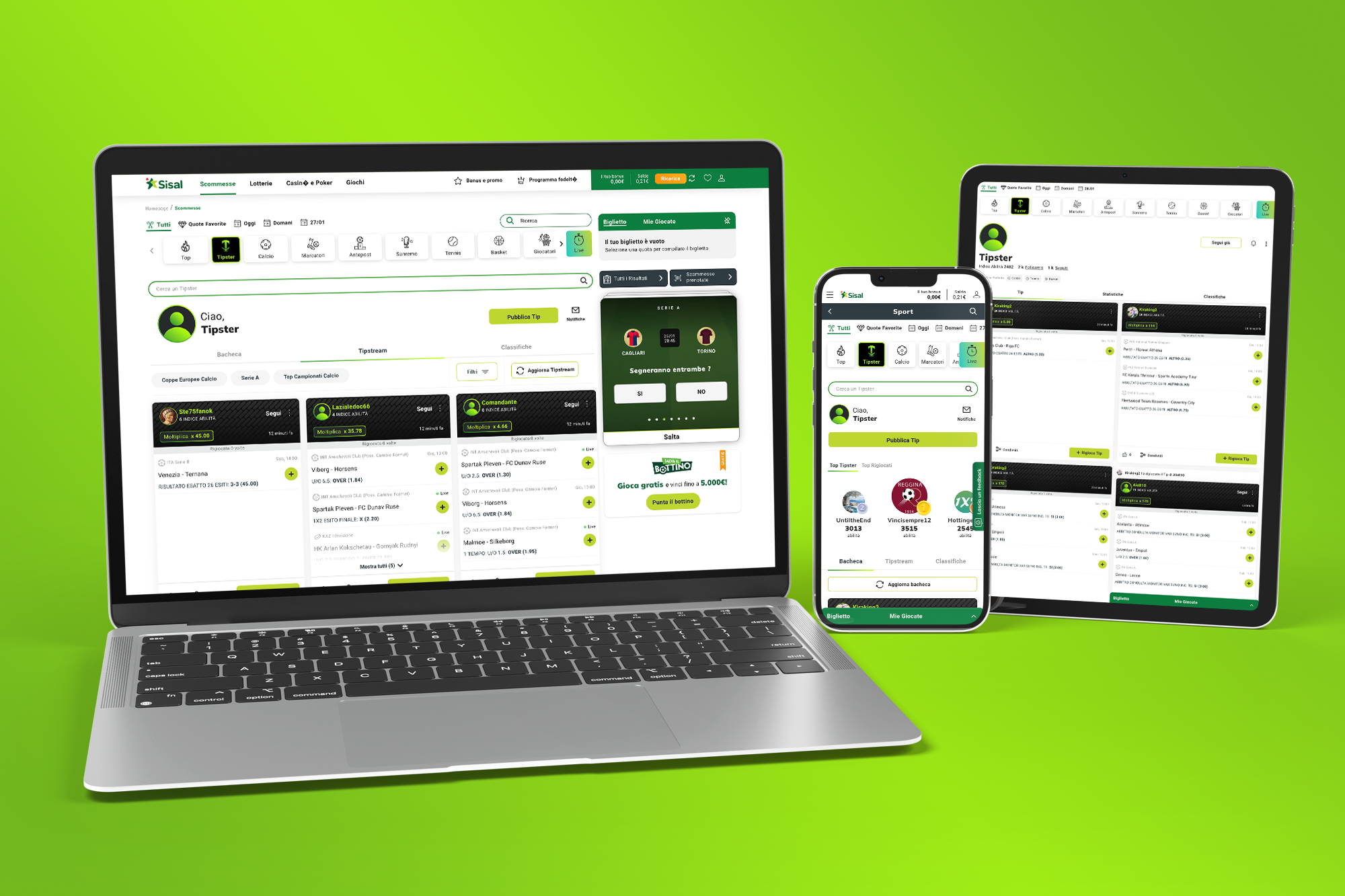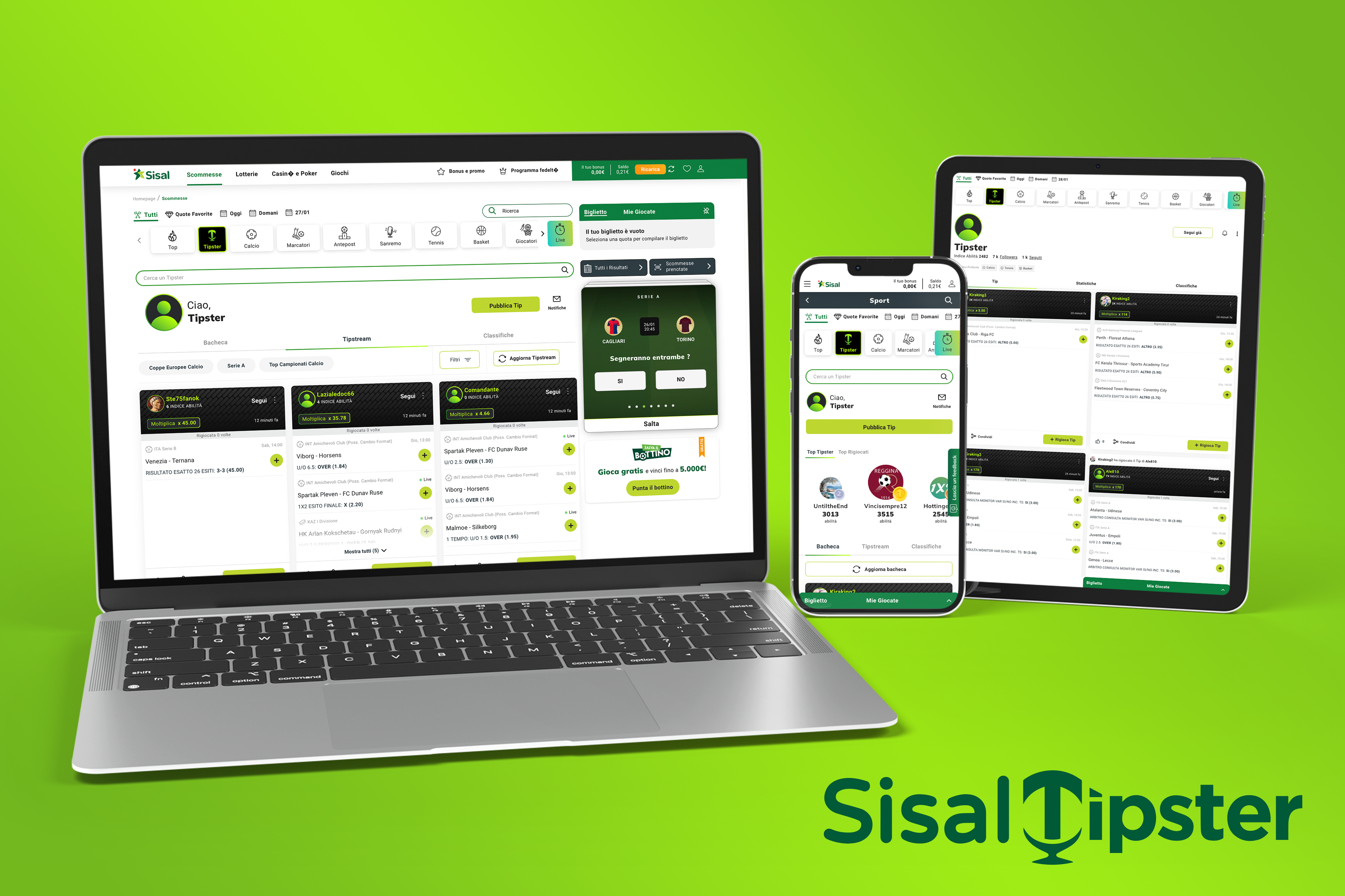
Client > Sisal Group
Industry > Gaming
Project Goal > UX/UI Product design
Timeline > Dec ’20 – Mar ’22
My Role > Sr UX/UI Designer
Responsibilities:
Research, Data Analysis, Wireframing, Prototyping, UI Design, UAT, Agile Collaboration
Tools > Miro, Adobe Suite, Figma
overview
Sisal Tipster: the first betting social network in Italy
Tipster is the innovative social betting platform by Sisal, one of the leading international operators in the regulated gaming industry (part of Flutter Entertainment plc since Aug ’22).
A platform, free of charge, where Sisal users can show their skills by sharing their bets, or simply taking a cue from other tipsters; the integrated social logic let users to interact, like and follow each other, taking inspiration by the influencers top tipsters.

Challenge
An unparalleled product on Italian market
Tipster was the absolutely first betting social platform on Italian market: as a product with no precedent, a great attention has been paid to user research phase, to create a highly desirable and usable product, with a strong customer-centered approach.
The challange has been to integrate the usual social network’s dynamics in an online betting context.
Context
Right context and right people to apply an Agile methodology
The Agile methodology is a project management approach that involves breaking the project into phases and emphasizes continuous collaboration and improvement. Teams follow a cycle of planning, executing, and evaluating.

Sisal had the right mix of people, knowledge and skills (on top to really structured teams for each department) to collaborate applying this methodology.
As the only designer on the project at the beginning of it, I had the opportunity to set our internal processes with product owners and dev team, thanks to a great communication by all and a meaningful willingness to learn, think, share in order to achieve common goals.
Deeply working hands-on Tipster gave me a wide knowledge about it, becoming in few time the historical memory of the project, design side; this led me to be one of the stakeholders during a round (of two important ones) of user research performed by two external providers (Conflux and H-Farm).
As the project grew, the dedicated design team did it as well, so I found myself to lead a team of 4 people on this fantastic and innovative product.
Methodology
Scrum: a specific framework within the broader Agile methodology
Let’s understand how, in Sisal, UX design fit into Agile methodologies.
Since Agile is an engineering practice, it didn’t have UX and design in its core principles; our role was to amalgamate the usual UX design practices with Agile project management.
UX/UI designers worked in strict collaboration with other team members such as Product managers, Owners or Specialists on business side, and Scrum master and Dev team on the other one, on activities defined at every stage, to be able to build cohesive products or features.
-
Kickoff meeting, with design team
The kickoff meeting was a crucial event, marking the beginning of a new project or a new phase within a project, with the purpose of aligning team members, stakeholders, and everyone involved with the project on the goals, objectives and expectations.
After a kickoff meeting, we designers evaluated the efforts in terms of time and people to create the features as requested.
-
User stories, part of the Sprint planning
A user story was a concise description of a feature or functionality from an end user’s perspective. It was a way of expressing requirements in an easily understandable format by both technical and non-technical team members.
During the Sprint Planning, a Scrum master helped the team to select user stories, from an organized product backlog, to work on during the upcoming sprint (lasting 2 to 4 weeks), breaking them down into smaller tasks as needed.
At the end of every sprint, a releasable product (or a feature of it) was developed.
-
Daily standup meetings, part of the Sprint phase
A daily standup meeting was a brief and regular team meeting with the primary purpose of providing a quick status update and addressing any potential obstacles or challenges faced by team members.
By holding daily standup meetings, teams couldn quickly adapt to changes, stay aligned with project goals, and foster a collaborative environment. This was probably one of the most important part of the Sprint phase on Tipster project.
-
Weekly Follow up by design team
I usually set weekly meetings to update the working group, during design phase, to ensure no gaps between project specification and designs.
At the end of design phase, the final designs were shared with all the involved figures; if needed, designs were refined and, once completed, they were paired to related user stories on Jira to let developers start translating them in releasable products.
-
Sprint review and Sprint retrospective
The further step was a Sprint review, a meeting where the Scrum team presented the completed work to stakeholders and they provide feedback, to adjust the product backlog.
At the end of the cycle, a Sprint retrospective was held to reflect on the past sprint and to identify future opportunities for improvement.
Design
Many different features to create a cutting-edge product
When I was tasked on Tipster project, the platform was online since few months.
The amount of subscriptions was increasing week by week, altough at that time Tipster was more like a bets repository than something else. The attention of the company was really high, considering Tipster as the springboard to success in Betting industry.
A never stopping research at the core of the project
As the only UX/UI designer at the beginning of the project, I mainly worked on manteinance and developers’ requests; I started performing comparative analysis on different social networks, because I saw the potential evolution of the platform that way, one of a kind. I was intrigued by the creative challenge of bringing social network’s dynamics into a brand new product, without forgetting to guarantee conversions.
During 2021, the need to carry out a deep phase of research with users became central, and it was the right moment to involve an external partner (Conflux) to perform a research activity with users, in order to bring out cues from their needs and validate those feature that, on business prediction, could represent the evolution of the platform.
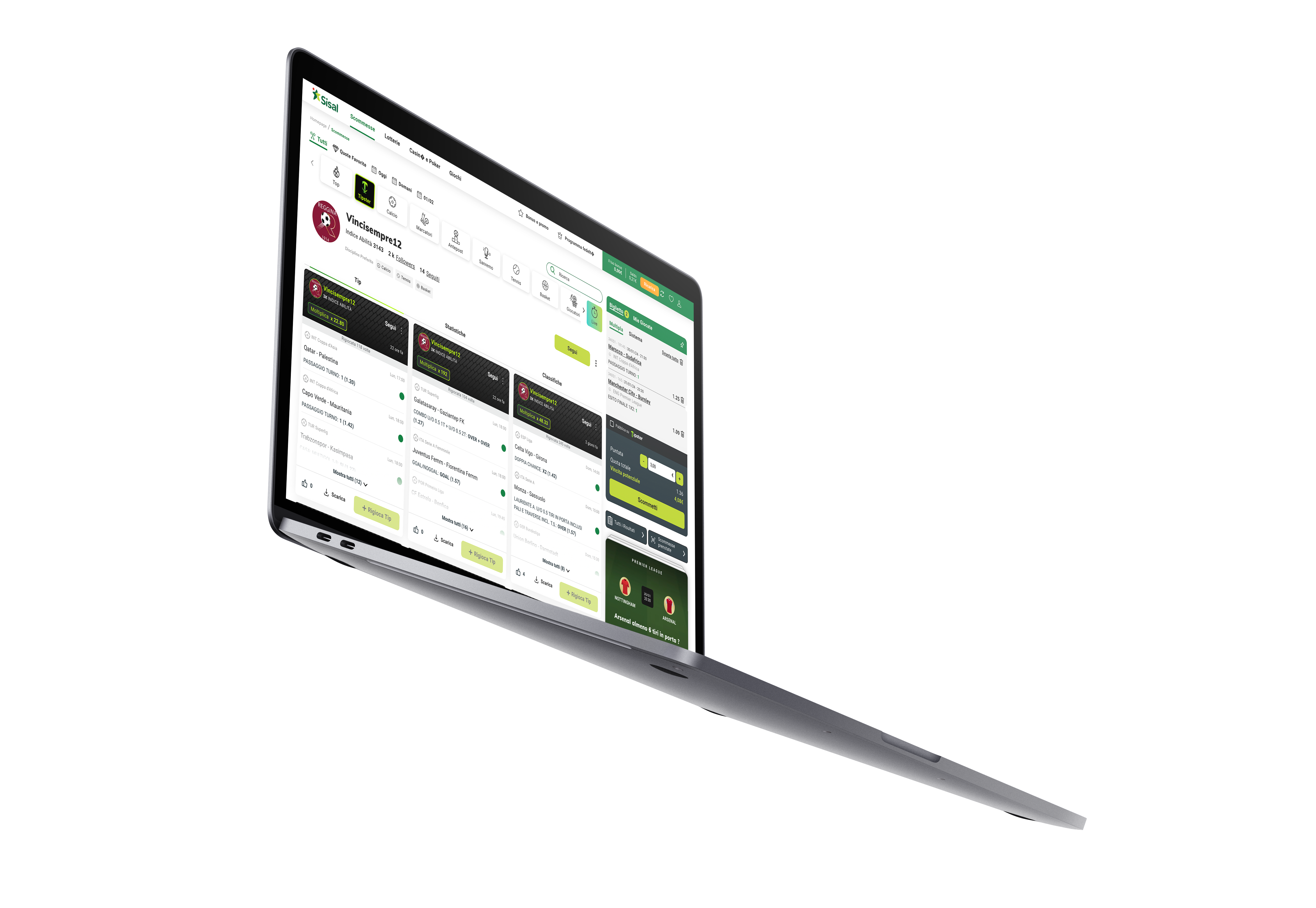
Here all the features I worked on, designing and leading Tipster project:
Tipster Reward
An automated mechanism, related to the received replay of shared tips, that allow users to receive a prize based on volumes (turnover) generated by their tips.
Tipster Filtering
A filtering system to provide users with the possibility of conducting more detailed searches
Tipster “Light” for Retail
The integration of a light Tipster version on Sisal stores’ physical devices.
Tipster Shared Bet
A feature allowing users to create shared bets.
Tipster P2P Challenge
A function to let users challenge each others.
Tipster Gamification
A series of features to set up typical gamification dynamics.
Tipster My Tipster
The setting up of a private area and a feed, along the lines of social networks, allowing users to search tipsters to follow according to their interests and preferred game modes
Tipster Avatar Customization
A feature allowing users to customise their avatar with those offered by the platform or with personal pictures.
Tipster Banners
Design of dedicated banners for different breakpoints.
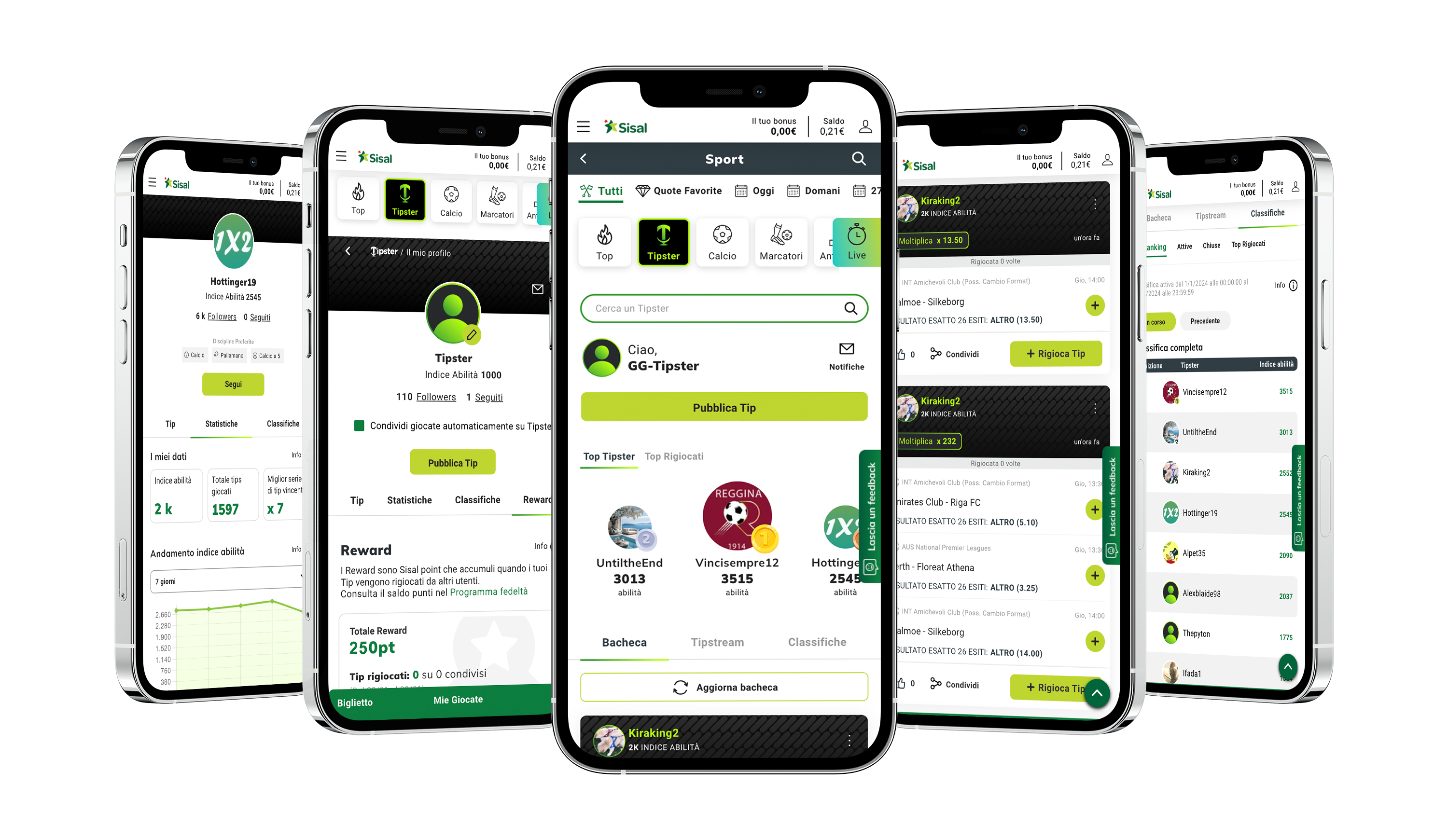
Goals
The planned functionalities, emerged from the first round of research by Conflux, were deepened and validated through a second round, held at the beginning of 2022 by H-Farm, also crossed with research material of our project dedicated team.
I personally took part in a two-days workshop, facilitated by H-Farm, alongside important stakeholders of the company, as a UX Betting specialist.
Goals could be summarized in:
-
Acquisitions: Increasing the user base and attracting new users
-
Retention: Customer retention and increased life time value
-
Increased activity per user: Encouraging users to increase the use of Tipster platform
-
Top users management: Increasing engagement of active and experienced users
-
Engagement: Involving and increasing interaction with and between users
-
Special initiatives: Creating new revenues with extra activities
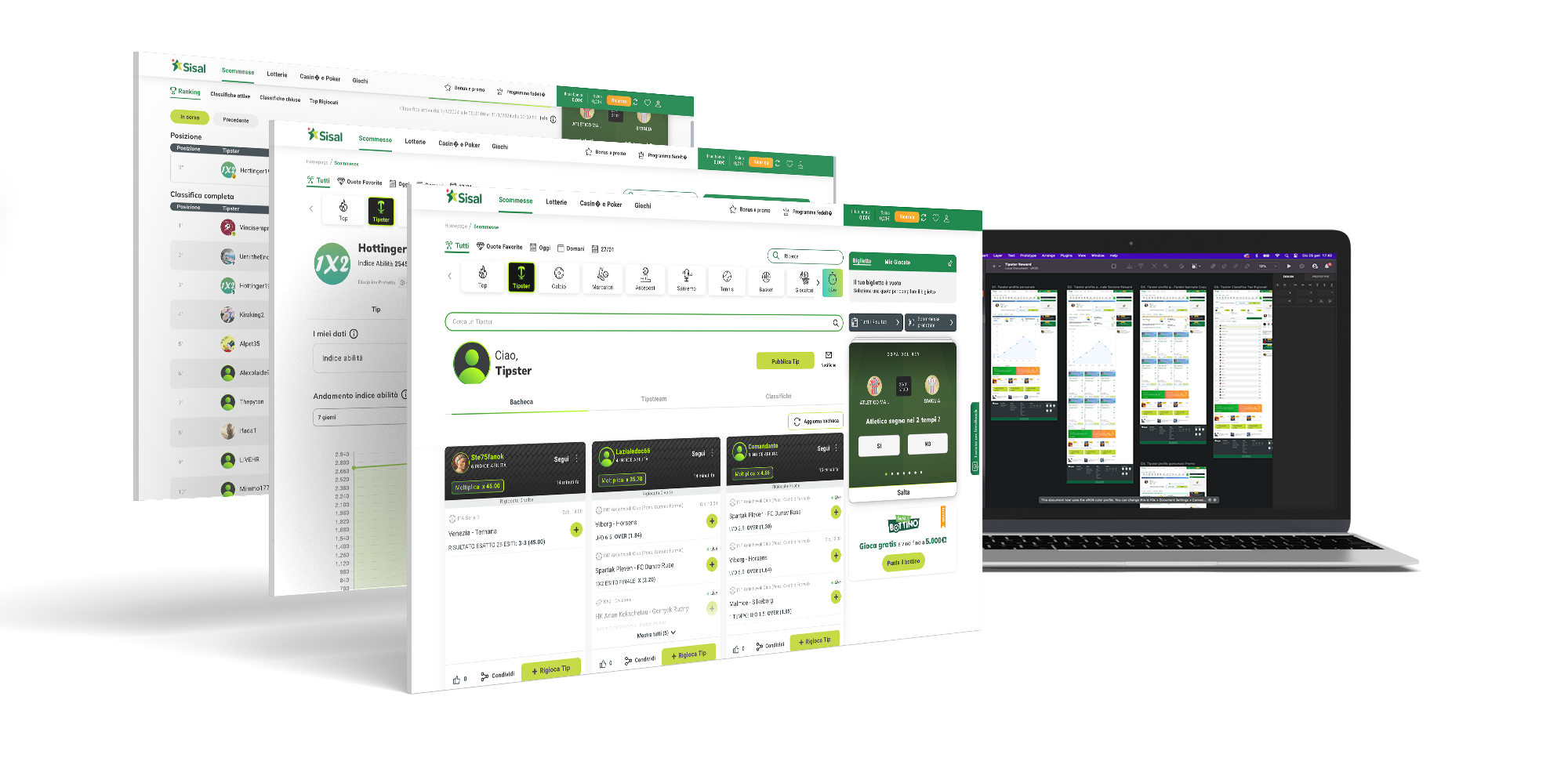
A close and honest collaboration at the base of the success
An eye to the business, another to development. In the middle me and my team working closely to give Tipster a cutting edge design, a great usability and to offer to the market the most innovative way of translating a strong intuition of the business.
Tight deadlines, clear requests and a long list of productions, working shoulder to shoulder with product owners, designers, researchers and developers, made Tipster a challenging but also the most satisfying professional challenge of my working experience.
Outcome
Since launch, Tipster have had a great impact on Italian market.
In October 2021, Sisal Tipster has been awarded as “Best in-house product innovation” at EGR Italy Awards 2021, and Sisal has also been awarded as “Best Operator of the year 2021”.
In September 2022, the statistics said:
-
more than 100.000 subscribers
-
8 millions tips shared on the platform
In June 2023, It’s been recorded the higher odd (100) for a win, the biggest ever on sports betting, on a tip shared by 6000 users.
